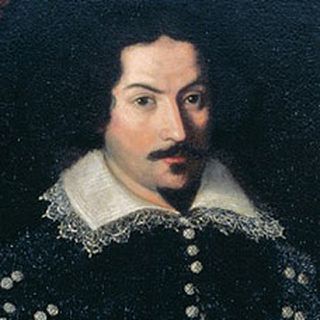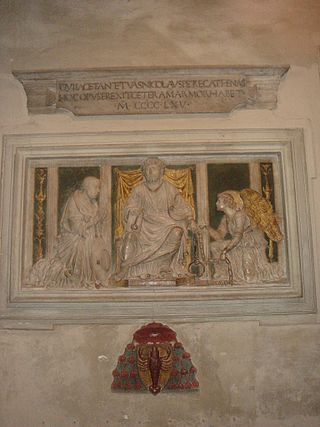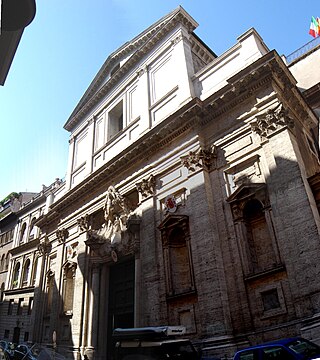
Carlo Maderno (Maderna) was an Italian architect, born in today's Ticino, Switzerland, who is remembered as one of the fathers of Baroque architecture. His façades of Santa Susanna, St. Peter's Basilica and Sant'Andrea della Valle were of key importance in the evolution of the Italian Baroque. He is often referred to as the brother of sculptor Stefano Maderno, but this is not universally agreed upon.

The Parish Basilica of Santa Maria del Popolo is a titular church and a minor basilica in Rome run by the Augustinian order. It stands on the north side of Piazza del Popolo, one of the most famous squares in the city. The church is hemmed in between the Pincian Hill and Porta del Popolo, one of the gates in the Aurelian Wall as well as the starting point of Via Flaminia, the most important route from the north. Its location made the basilica the first church for the majority of travellers entering the city. The church contains works by several famous artists, such as Raphael, Gian Lorenzo Bernini, Caravaggio, Alessandro Algardi, Pinturicchio, Andrea Bregno, Guillaume de Marcillat and Donato Bramante.

There are more than 900 churches in Rome, which makes it the city with the largest number of churches in the world. Almost all of these are Catholic.

San Francesco a Ripa is a church in Rome, Italy. It is dedicated to Francis of Assisi who once stayed at the adjacent convent. The term Ripa refers to the nearby riverbank of the Tiber.

San Marcello al Corso, a church in Rome, Italy, is a cardinalitial titular church whose cardinal-protector is normally of the order of cardinal priests.

Santa Maria dei Miracoli and Santa Maria di Montesanto are two churches in Rome.

Filippo Barigioni (1690–1753) was an Italian sculptor and architect working in the Late Baroque tradition.

Pierre Le Gros was a French sculptor, active almost exclusively in Baroque Rome where he was the pre-eminent sculptor for nearly two decades.

Andrea di Cristoforo Bregno (1418–1506) was an Italian Renaissance sculptor and architect of the Early Renaissance who worked in Rome from the 1460s and died just as the High Renaissance was getting under way.

Santa Maria in Campitelli or Santa Maria in Portico is a church dedicated to the Virgin Mary on the narrow Piazza di Campitelli in Rione Sant'Angelo, Rome, Italy. The church is served by the Clerics Regular of the Mother of God.

San Francesco da Paola ai Monti is an 18th-century titular church in Rome. It is dedicated to St Francis of Paola, and is located in the Monti rione.

Antonio Maria Salviati was a Florentine Roman Catholic cardinal.

The Spanish National Church of Santiago and Montserrat, known as Church of Holy Mary in Monserrat of the Spaniards is a Roman Catholic titulus church and National Church in Rome of Spain, dedicated to the Virgin of Montserrat. It is located in the Rione Regola, at the intersection of alleyway of Via della Barchetta and the narrow Via di Monserrato, with the facade on the latter street, about three blocks northwest of the Palazzo Farnese.

Bernardino Ludovisi, also called Bernardo, was an Italian sculptor.
Marchese GerolamoTheodoli was an Italian nobleman and architect, best known for designing the Teatro Argentina in Rome.

The hospital of San Giacomo in Augusta, also known as San Giacomo degli Incurabili was a historic hospital located in Rome.

The Ospedale degli Incurabili or Complesso degli Incurabili is an ancient and prominent hospital complex located on Via Maria Longo in central Naples, Italy. Part of the complex, including the remarkable pharmacy, are now the Museo delle arti sanitarie of Naples.

Chibly Langlois is a Haitian cardinal of the Catholic Church. He has served as Bishop of Les Cayes since 15 August 2011, and is also president of Haiti’s Bishops’ Conference.

The Sala Lancisiana is a renaissance building located in Rome, part of the hospital of San Giacomo degli Incurabili, and site of an anatomical theatre. It was built at the end of the 16th century by the architect Francesco Capriani at the behest of Cardinal Anton Maria Salviati, and named after the physician Giovanni Maria Lancisi.

Santa Maria Portae Paradisi is a catholic church in Rome, in the Rione Campo Marzio, along via di Ripetta.






















